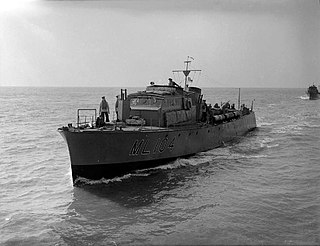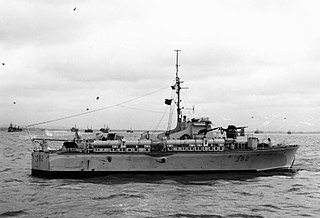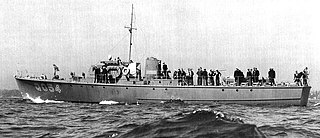
A motor torpedo boat is a fast torpedo boat, especially of the mid 20th century. The motor in the designation originally referred to their use of petrol engines, typically marinised aircraft engines or their derivatives, which distinguished them from other naval craft of the era, including other torpedo boats, that used steam turbines or reciprocating steam engines. Later, diesel-powered torpedo boats appeared, in turn or retroactively referred to as "motor torpedo boats" for their internal combustion engines, as distinct from steam powered reciprocating or turbine propulsion.

The motor gunboat (MGB) was a small, high-speed British military vessel of the Second World War, which was armed with a mix of guns, in contrast to the physically similar motor torpedo boat (MTB), whose main offensive weapon were torpedoes. The small size of the MGBs, and their high speed, made them difficult targets for German E-boats, though, like their opponents, they were limited by heavy weather, because they did not provide a stable-enough platform to aim the guns. The large number of guns required a relatively large crew, numbering as high as thirty men on the largest boats.

The British Power Boat Company was a British manufacturer of motor boats from 1927 to 1946, particularly racing boats and later military patrol boats in Hythe, Hampshire.

The Fairmile B motor launch was a very numerous class of motor launch produced in kit form by British boatbuilder Fairmile Marine, and then assembled and fitted out by numerous boatyards during the Second World War to meet the Royal Navy's coastal operation requirements.

The Fairmile A motor launch was a coastal motor launch designed by Norman Hart for the Fairmile Marine for the Royal Navy in World War II. The prototype ML 100 was privately built by the British industrialist Noel Macklin, who placed an order for this craft on 27 July 1939 with Woodnut's boatyard at St Helens. The Admiralty placed an order for a series of 25 boats to this design on 22 September, including the prototype under construction. The twelve boats completed to this initial design were numbered ML 100 to ML 111, while the thirteen other boats ordered on 22 September were re-ordered to the Admiralty's own Fairmile B design.

The Fairmile C motor gun boat was a type of motor gunboat designed by Norman Hart of Fairmile Marine for the Royal Navy. An intermediate design, twenty-four boats were ordered on 27 August 1940 from Fairmile Marine in kit form and were assembled at multiple boatbuilders' yards and completed in 1941; they were initially rated as Motor Launches (ML), but received the designation Motor Gun Boats (MGB) on 1 August 1941, being numbered MGB 312–335.

The Fairmile D motor torpedo boat was a type of British motor torpedo boat (MTB) and motor gunboat (MGB), conceived by entrepreneur Noel Macklin of Fairmile Marine and designed by naval architect Bill Holt for the Royal Navy. Nicknamed "Dog Boats", they were designed to be assembled in kit form mass-produced by the Fairmile organisation and assembled at dozens of small boatbuilding yards around Britain, to combat the known advantages of the German E-boats over previous British coastal craft designs. At 115 feet in length, they were bigger than earlier MTB or motor gunboat (MGB) designs but slower, at 30 knots compared to 40 knots.
Sir (Albert) Noel Campbell Macklin was an innovative British car maker and boat designer. He founded Eric-Campbell in 1919, Silver Hawk in 1920, Invicta in 1925 and Railton in 1933. In 1939 he founded Fairmile Marine and supplied boats to the Royal Navy throughout World War II, for which effort he was honoured with a knighthood.

Coastal Forces was a division of the Royal Navy initially established during World War I, and then again in World War II under the command of Rear-Admiral, Coastal Forces. It remained active until the last minesweepers to wear the "HM Coastal Forces" cap tally were taken out of reserve in 1968. The division received more gallantry awards than any other branch of the Royal Navy during that period.

Steam gun boats (SGBs) were small Royal Navy vessels built from 1940 to 1942 for Coastal Forces during World War II. The class consisted of nine steam-powered torpedo boats.

The Coastal Forces of the Royal Canadian Navy (RCN) was a specialized naval force of well-armed, small and fast motor launch (ML) and motor torpedo boat (MTB) flotillas, primarily crewed by members of the Royal Canadian Naval Volunteer Reserve (RCNVR). Tasked with escort, coastal defence, anti-submarine, minesweeping and search and rescue duties, the Coastal Forces of the RCN contributed to securing Allied sea lines of communication off the coasts of Canada and Britain during the Second World War.

The Vosper 73 foot Motor Torpedo Boat was a mid-twentieth century British motor torpedo boat (MTB) designed by Vosper that served in the Royal Navy Coastal Forces during the Second World War.

Angus Konstam is a Scottish writer of popular history. Born in Aberdeen, Scotland and raised on the Orkney Islands, he has written more than a hundred books on maritime history, naval history, historical atlases, with a special focus on the history of piracy.

HMC ML Q050 was the first of a series of wooden Canadian-built Fairmile B motor launch (ML) boats delivered to the Royal Canadian Navy (RCN) on 18 November 1941. Originally designed for the Royal Navy by W.J. Holt of the British Admiralty and built by British boatbuilder Fairmile Marine, during the Second World War 80 Fairmile B motor launches were built in Canada for service with the Coastal Forces of the RCN.

HMC ML Q051 was a wooden Canadian-built Fairmile B motor launch (M.L.) upgunned submarine chaser delivered to the Royal Canadian Navy (RCN) on 24 November 1941. Originally designed for the Royal Navy by W.J. Holt of the British Admiralty and built by British boatbuilder Fairmile Marine, during the Second World War eighty Fairmile B motor launches were built in Canada for service with the Coastal Forces of the RCN.

HMC MLQ052 was a wooden Fairmile B motor launch (ML) upgunned submarine chaser delivered to the Royal Canadian Navy (RCN) on 31 October 1941. Originally designed for the Royal Navy by W.J. Holt of the British Admiralty and built by British boatbuilder Fairmile Marine, during the Second World War eighty Fairmile B motor launches were built in Canada for service with the Coastal Forces of the RCN.

HMC ML Q054 was a wooden Canadian-built Fairmile B motor launch (ML) upgunned submarine chaser delivered to the Royal Canadian Navy (RCN) on 17 October 1941. Originally designed for the Royal Navy by W.J. Holt of the British Admiralty and built by British boatbuilder Fairmile Marine, during the Second World War eighty Fairmile B motor launches were built in Canada for service with the Coastal Forces of the RCN.

HMC ML Q055 was a wooden Canadian-built Fairmile B motor launch (ML) upgunned submarine chaser delivered to the Royal Canadian Navy (RCN) on 6 November 1941. Originally designed for the Royal Navy by W.J. Holt of the British Admiralty and built by British boatbuilder Fairmile Marine, during the Second World War eighty Fairmile B motor launches were built in Canada for service with the Coastal Forces of the RCN.

The Canadian Fairmile B was a motor launch built during the Second World War for the Royal Canadian Navy. They were adaptations of the British Fairmile B motor launch design incorporating slight modifications for Canadian climatic and operational conditions. Eighty-eight were built in Canada for service with the Coastal Forces of the Royal Canadian Navy in home waters, of which eight were supplied to the United States Navy.















